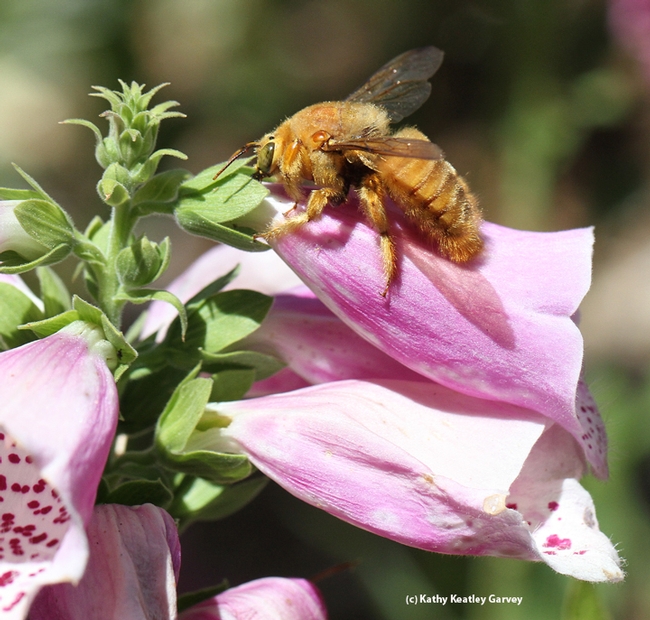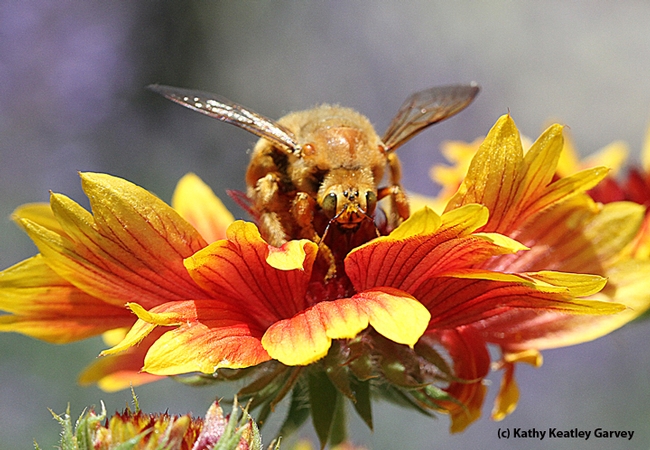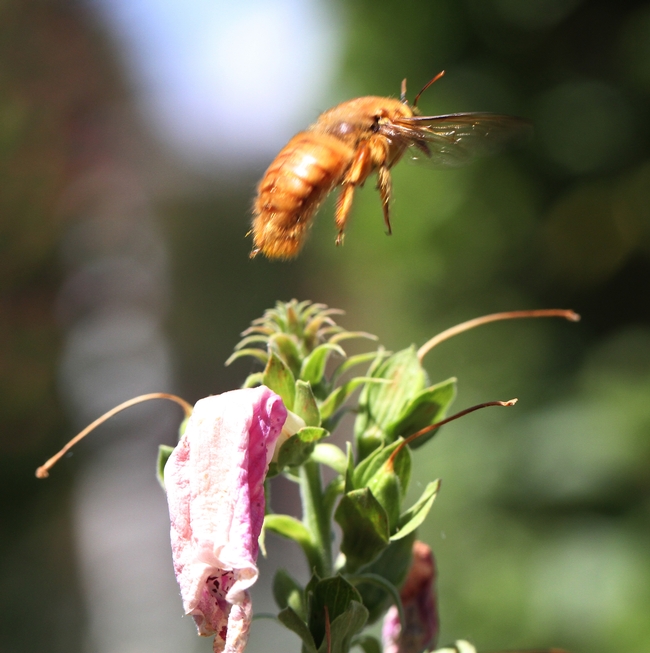- Author: Kathy Keatley Garvey
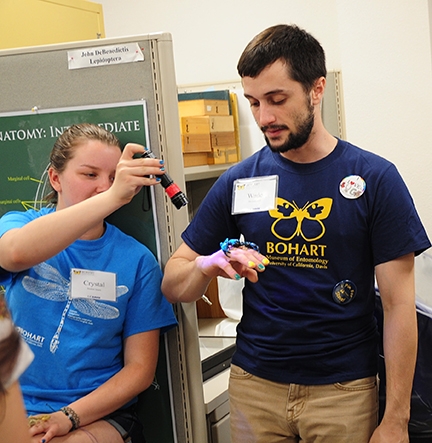
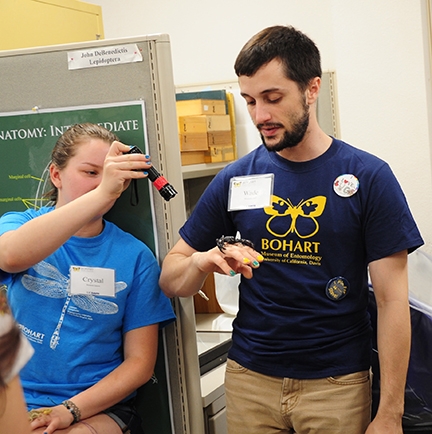
It was Saturday, April 18, the 103rd annual UC Davis Picnic Day, a campuswide open house, and several thousand folks filed into the Bohart Museum of Entomology to see the displays. The theme: "Bigger, Better, Buglier: Impressive Science."
Native pollinator specialist Robbin Thorp, distinguished emeritus professor of entomology, UC Davis Department of Nematology and Nematology, displayed male Valley carpenter bees he netted in the UC Davis Häagen-Dazs Honey Bee Haven (and later released there).
And in an amazing moment, a young boy, wearing a bumble bee t-shirt, walked up to see the bees. "My kind of guy!" quipped Thorp when he saw Adne Burruss, 6, of Irvine. Thorp is the co-author of Bumble Bees of North America: an Identification Guide (Princeton University) and California Bees and Blooms: A Guide for Gardeners and Naturalists (Heyday). Adne's mother, Sigrid Burruss, a geneticist, is a UC Davis alumnus.
The male Valley carpenter bee (Xylocopa varipuncta), a green-eyed blond, is also known as "the teddy bear bee." The female of the species is solid black. Thorp urged visitors to touch the carpenter bee. "Boy bees don't sting," he assured them. He also displayed specimens of bumble bees and other native bees.
Bohart Museum associate Wade Spencer, an undergraduate majoring in entomology, brought along his pet scorpions. Assisting him was Crystal Homicz, an animal biology major. She periodically pointed a black light on his scorpion to show the fluorescence. (Visitors were not allowed to touch the scorpions, which are known for their venomous sting.)
Entomologist and Bohart Museum associate Jeff Smith, who curates the butterfly and moth specimens, drew in visitors with his colorful butterfly and moth specimens and kept their attention as he talked about the places he's been and the insects he's seen.
Julianna Amaya, 10, of Martinez, was fascinated with the Australia walking sticks. She and sister, Jasmine, 14, and their mother, Rocio, watched it crawl up their hands. "Julianna is really into bugs," mom said.
The Bohart Museum, founded in 1946 and named for prominent entomologist Richard M.Bohart, is located in Room 1124 of the Academic Surge Building on Crocker Lane. Directed by Lynn Kimsey, professor of entomology at UC Davis, it is the home of nearly eight million insect specimens; a live petting zoo (including Madagascar hissing cockroaches, walking sticks and tarantulas); and a year-around gift shop stocked with T-shirts, sweatshirts, books, jewelry, posters, insect-collecting equipment and insect-themed candy.
Fran Keller, an assistant professor at Folsom Lake College who received her doctorate in entomology from UC Davis (major professor Lynn Kimsey) talked to visitors about insects and also kept busy with sales at the gift shop. Lady beetle t-shirts and monarch t-shirts proved popular.
The Bohart Museum's regular hours are from 9 a.m. to noon and 1 to 5 p.m. Mondays through Thursdays. The museum is closed to the public on Fridays, Saturdays and Sundays and on major holidays. Admission is free.
More information on the Bohart Museum is available by contacting (530) 752-0493 or bmuseum@ucdavis.edu.
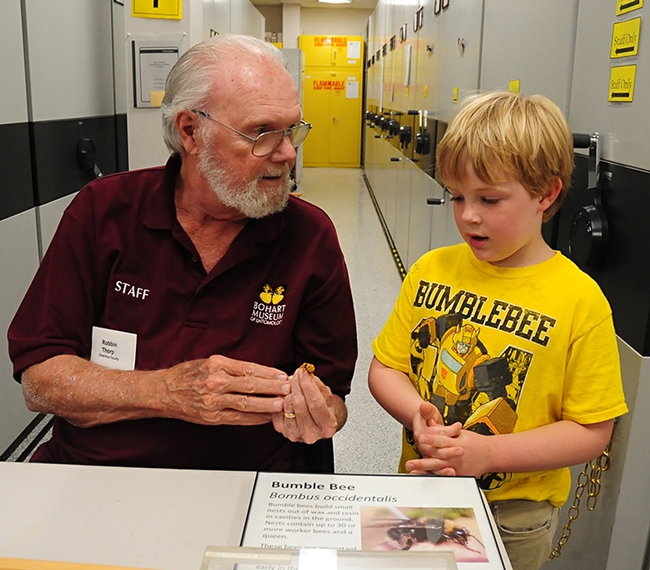
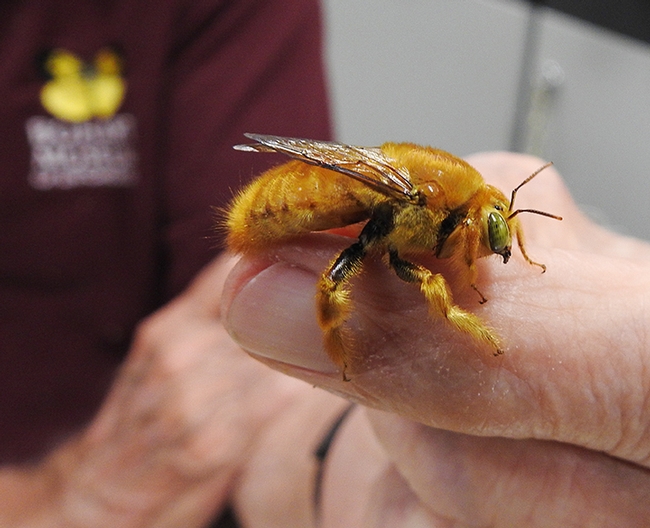
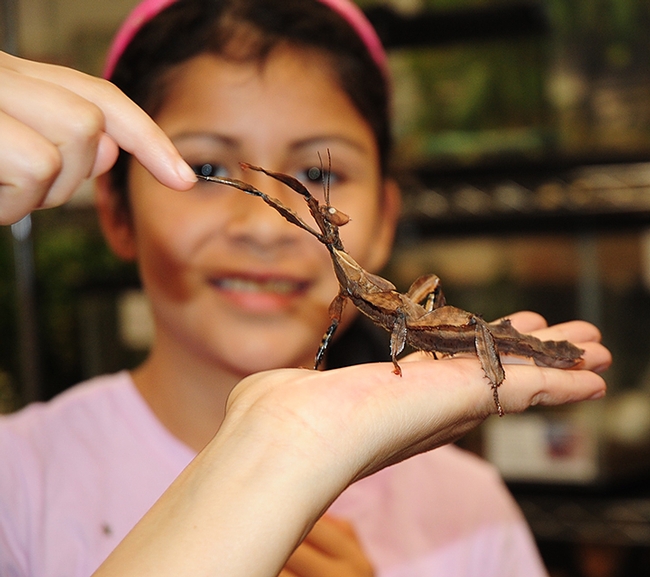
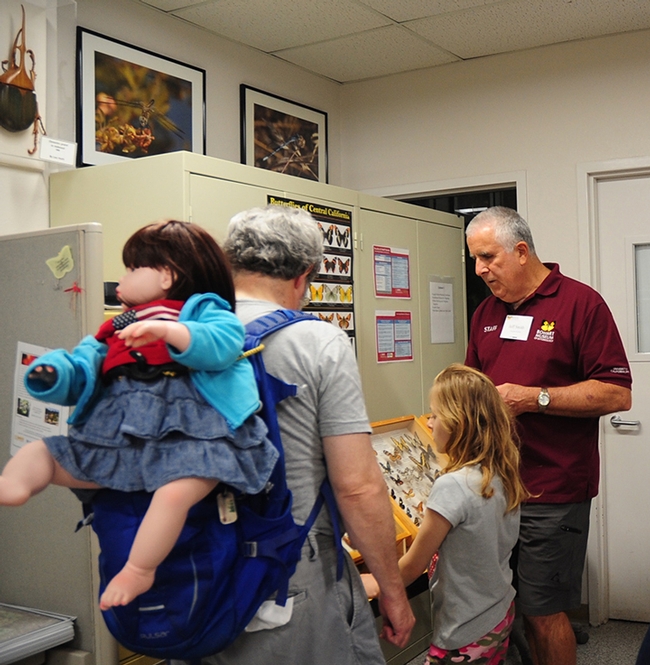
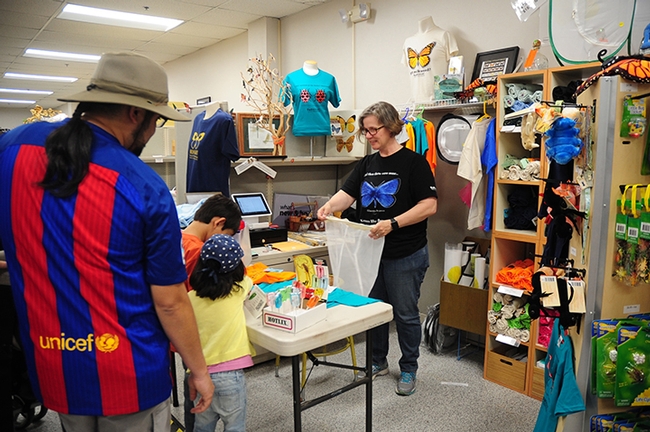
- Author: Kathy Keatley Garvey
Oh, that cuddly teddy bear.
The male Valley carpenter bee, Xylocopa varipuncta, also known as "the teddy bear bee," comes around occasionally to nectar our broadleaf milkweed, Asclepias speciosa, in our pollinator garden.
The milkweed is the larval host of the monarch butterfly, but other insects, including the honey bees, carpenter bees, leafcutter bees, and butterflies, stop by to sip some nectar.
The male Valley carpenter bee joined the party, and what a party it was. He bluffed his way past the other insects--boy bees do not sting as they have no stinger, as native pollinator specialist Robbin Thorp distinguished emeritus professor of entomology at the University of California, Davis, says.
A monarch fluttered in for a little nectar, too, but the teddy bear bee refused to budge.
When you're big, hungry, and a bluffer, you can do that.



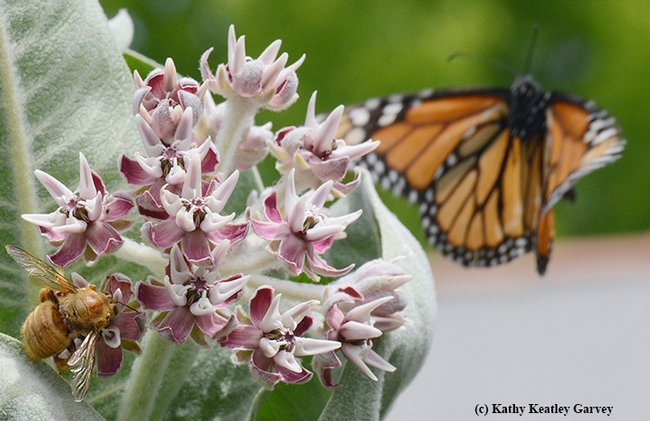
- Author: Kathy Keatley Garvey
If you've never seen the "teddy bear bee," keep an eye out for it.
A fuzzy golden bee with green eyes, it's the male Valley carpenter bee (Xylocopa varipuncta). Last Friday we saw it foraging in the half-acre Haagen-Dazs Honey Bee Haven on Bee Biology Road, University of California, Davis. It decidedly preferred the foothill penstemon, Penstemon heterophyllus.
Gold on purple. Purple on gold. It seemed like royalty.
It paid no attention to the photographer. It proceeded to "rob the nectar," that is, drill a hole in the outside of the corolla in its short cut to reach the nectar, thus bypassing the usual method of pollination.
It looked huge. That's because it is. At one inch long, Xylocopa varipuncta is considered the largest bee found in California. The species is also a striking example of sexual biphorism--the female is solid black while the male is blond.
Native pollinator specialist Robbin Thorp, distinguished professor of entomology at UC Davis, enjoys showing the teddy bear bee to folks at open houses at the haven and Bohart Museum of Entomology and at other special events.
"It's a male and can't sting you," he assures cautious onlookers "Males have no stingers."
The Valley carpenter bee, so-called because it's common in the Central Valley of California, is one of our native bees. Its range includes an area from western New Mexico to southern California.
Look for it, too, in the Haagen-Dazs Honey Bee Haven, located west of the central campus and operated by the UC Davis Department of Entomology and Nematology. The garden is open to the public--free admission and free parking--from dawn to dusk.
You might see it on the penstemon and on the passionflower vine.
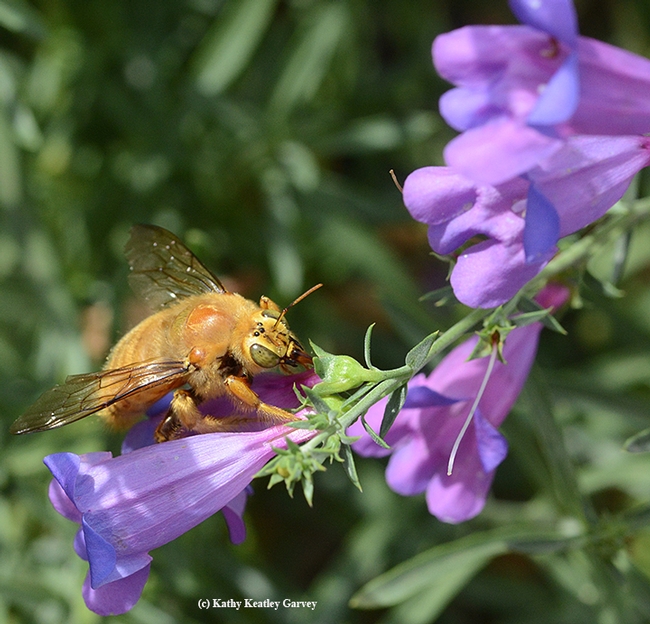


- Author: Kathy Keatley Garvey
If you've ever wanted to taste exotic honeys (of course, you have!) and if you've ever wondered why native bees don't make honey (you have, haven't you?), then you're in luck.
The Honey and Pollination Center at the University of California, Davis, is hosting an international honey tasting event on Tuesday, April 5 in the Robert Mondavi Institute for Wine and Food Science (RMI) Sensory Theater, and you're invited.
The event, billed as The World of Honey--International Honey Tasting, will take place from 6:30 to 8 p.m. at RMI, located on Old Davis Road, UC Davis campus.
Participants will experience four exotic international honeys: stingless bee honey from Brazil, coffee blossom from Guatemala, Viper's Bugloss from New Zealand, and chestnut honey from France.
Amina Harris, director of the Honey and Pollination Center, will lead the tasting. The event opens with a short talk and PowerPoint on stingless bees and native bees by Robbin Thorp, distinguished emeritus professor, UC Davis Department of Entomology and Nematology.
"Stingless bees were raised by the Mayans for honey," Harris says. "Today stingless bee honey production is very low."
In his talk,Thorp will discuss the diversity of bees (20,000 species in the world) and why most bees do not produce honey. He also will cover "which ones produce honey that we do harvest, primarily bees of the genus Apis and some of the many stingless bees."
Student tickets are $12.50, while tickets for UC Davis affiliates are $25, and $30 for the general public. To registrar, access the Honey and Pollination Center website at https://registration.ucdavis.edu/Item/Details/190 or contact Elizabeth Luu at luu@caes.ucdavis.edu or Amina Harris at aharris@ucdavis.edu. The last day to register online is Sunday, April 3.
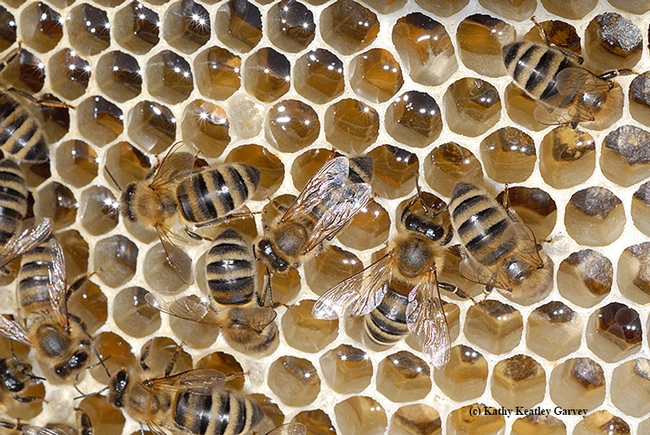
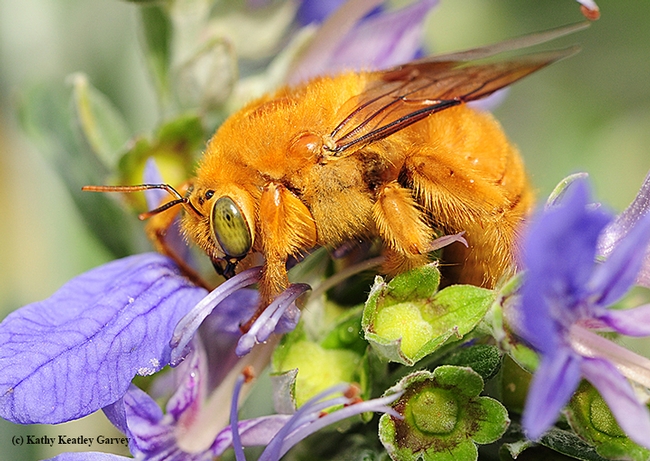
- Author: Kathy Keatley Garvey
I've been waiting for a decade to see a male Valley carpenter bee (Xylocopa varipuncta) foraging in our family bee garden.
The girls? Oh, yes. We see them every day. Sometimes half a dozen at a time. They're usually on the salvia or passionflower vine.
The boys? No. They do not go where our girls are. I saw a solo fly-by a couple of years ago, but he did not stop.
Then last Saturday, a male Valley carpenter bee dropped down and nectared on the foxgloves (Digitalis purpurea), the dwarf bulbine (Bulbine frutescens), the catmint (Nepeta) and the blanket flower (Gaillardia x grandiflora).
In that order.
To be honest, a very territorial European male carder bee (Anthidium manicatum) chased him off the foxgloves, so our big boy headed for the catmint and then the blanket flower, where he encountered only docile honey bees.
The male Xylocopa varipuncta is the insect that results in so many similar calls--"I found a golden bumble bee! Is it a new species?" A bumble bee it is not. A carpenter bee it is.
Native pollinator specialist Robbin Thorp, distinguished emeritus professor of entomology at the University of California, Davis, calls the male Valley carpenter bees "teddy bears." That's because they're green-eyed, blond and fuzzy-wuzzy. Thorp reminds curious kids and apprehensive adults that "boy bees can't sting."
Thorp often displays a female Valley carpenter bee (solid black) alongside the blond male to show the sexual dimorphism, or what Wikipedia explains is a phenotypic differentiation between males and females of the same species.
The Boy Wonder is sort of like a blond Marilyn Monroe male courting a Clarkette Gable.
What happened when the Boy Wonder left the blanket flower? He returned to the foxgloves.
Just briefly. Until the wool carder bee targeted him again.
